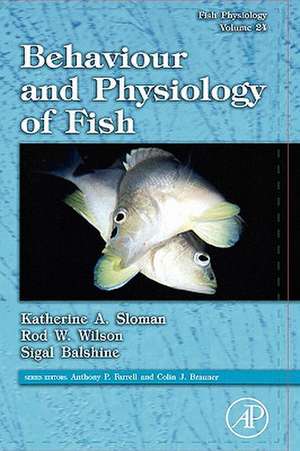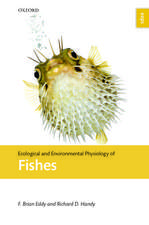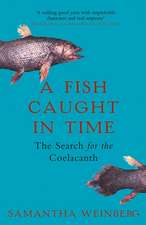Fish Physiology: Behaviour and Physiology of Fish: Fish Physiology, cartea 24
Editat de Katherine A. Sloman, Sigal Balshine, Rod W. Wilsonen Limba Engleză Hardback – 19 dec 2005
- Multidisciplinary and integrative research in fish biology
- Written by internationally recognized researchers
- Encompasses the whole life span of fish
- A wide variety of inter-related topics presented in a cohesive format
Din seria Fish Physiology
- 27%
 Preț: 969.52 lei
Preț: 969.52 lei - 27%
 Preț: 1156.07 lei
Preț: 1156.07 lei - 23%
 Preț: 570.59 lei
Preț: 570.59 lei - 8%
 Preț: 483.18 lei
Preț: 483.18 lei - 24%
 Preț: 524.58 lei
Preț: 524.58 lei - 18%
 Preț: 522.69 lei
Preț: 522.69 lei - 23%
 Preț: 498.09 lei
Preț: 498.09 lei - 9%
 Preț: 562.99 lei
Preț: 562.99 lei - 31%
 Preț: 495.93 lei
Preț: 495.93 lei - 21%
 Preț: 498.47 lei
Preț: 498.47 lei - 17%
 Preț: 497.35 lei
Preț: 497.35 lei - 27%
 Preț: 557.55 lei
Preț: 557.55 lei - 38%
 Preț: 498.78 lei
Preț: 498.78 lei - 9%
 Preț: 506.27 lei
Preț: 506.27 lei - 11%
 Preț: 665.44 lei
Preț: 665.44 lei
Preț: 593.60 lei
Preț vechi: 957.10 lei
-38% Nou
Puncte Express: 890
Preț estimativ în valută:
113.60€ • 118.16$ • 93.78£
113.60€ • 118.16$ • 93.78£
Carte tipărită la comandă
Livrare economică 05-19 aprilie
Preluare comenzi: 021 569.72.76
Specificații
ISBN-13: 9780123504487
ISBN-10: 0123504481
Pagini: 504
Ilustrații: Illustrated
Dimensiuni: 152 x 229 x 26 mm
Greutate: 0.94 kg
Editura: ELSEVIER SCIENCE
Seria Fish Physiology
ISBN-10: 0123504481
Pagini: 504
Ilustrații: Illustrated
Dimensiuni: 152 x 229 x 26 mm
Greutate: 0.94 kg
Editura: ELSEVIER SCIENCE
Seria Fish Physiology
Public țintă
Marine scientists, fish researchers, undergraduate students studying fish behavior, fishery biologists, and physiologists.Cuprins
1. Cognitive Ability in Fish (Victoria A. Braithwaite)
2. Communication (Gil G. Rosenthal and Phillip S. Lobel)
3. The Physiology of Antipredator Behaviour: What You do With What You’ve Got (Mark Abrahams)
4. Effects of Parasites on Fish Behaviour: Interactions with Host Physiology (Iain Barber and Hazel A. Wright)
5. Social Interactions (Jörgen I. Johnsson, Svante Winberg and Katherine A. Sloman)
6. Circadian Rhythms in Fish (Irina V. Zhdanova and Stéphen G. Reebs)
7. Behavioural Physiology of Fish Migrations: Salmon as a Model Approach (Scott G. Hinch, Steven J. Cooke, Michael C. Healey and A. P. (Tony) Farrell)
8. Neuroendocrine Mechanisms of Alternative Reproductive Tactics in Fish (Rui F. Oliveira)
9. Reproductive Pheromones (Norm Stacey and Peter Sorensen)
10. Anthropogenic Impacts on Behaviour and Physiology (Katherine A. Sloman and Rod W. Wilson)
2. Communication (Gil G. Rosenthal and Phillip S. Lobel)
3. The Physiology of Antipredator Behaviour: What You do With What You’ve Got (Mark Abrahams)
4. Effects of Parasites on Fish Behaviour: Interactions with Host Physiology (Iain Barber and Hazel A. Wright)
5. Social Interactions (Jörgen I. Johnsson, Svante Winberg and Katherine A. Sloman)
6. Circadian Rhythms in Fish (Irina V. Zhdanova and Stéphen G. Reebs)
7. Behavioural Physiology of Fish Migrations: Salmon as a Model Approach (Scott G. Hinch, Steven J. Cooke, Michael C. Healey and A. P. (Tony) Farrell)
8. Neuroendocrine Mechanisms of Alternative Reproductive Tactics in Fish (Rui F. Oliveira)
9. Reproductive Pheromones (Norm Stacey and Peter Sorensen)
10. Anthropogenic Impacts on Behaviour and Physiology (Katherine A. Sloman and Rod W. Wilson)
Recenzii
"In Behaviour and Physiology of Fish, Katherine Sloman, Rod Wilson and Sigal Balshine have eminently addressed the intimate interplay of the underlying physiological processes and behavioural output that enable us to better understand the proximate mechanisms and functions of fish behaviour...With reference to the title of this book review, there is indeed something fishy going on, and the link between behaviour and physiology is detailed exquisitely here. I highly recommend this book to undergraduates and postgraduates who are interested in either realm or who intend to study a combination of mechanistic and functional questions regarding behaviour. Any fish biologist who wishes to understand the current state of the art should also read this book as a base for future studies. I do hope to see a second edition of this book since the editors tantalisingly mention genomics and proteomics in their introduction. Post-genomic technology should provide fresh new insight into the, as yet, elusive causes of particular behaviours in future studies. This is an exciting time for the field of behaviour and physiology and this book will provide an interesting read for those who share my enthusiasm." --Lynne U. Sneddon, University of Liverpool, UK, in THE JOURNAL OF EXPERIMENTAL BIOLOGY












